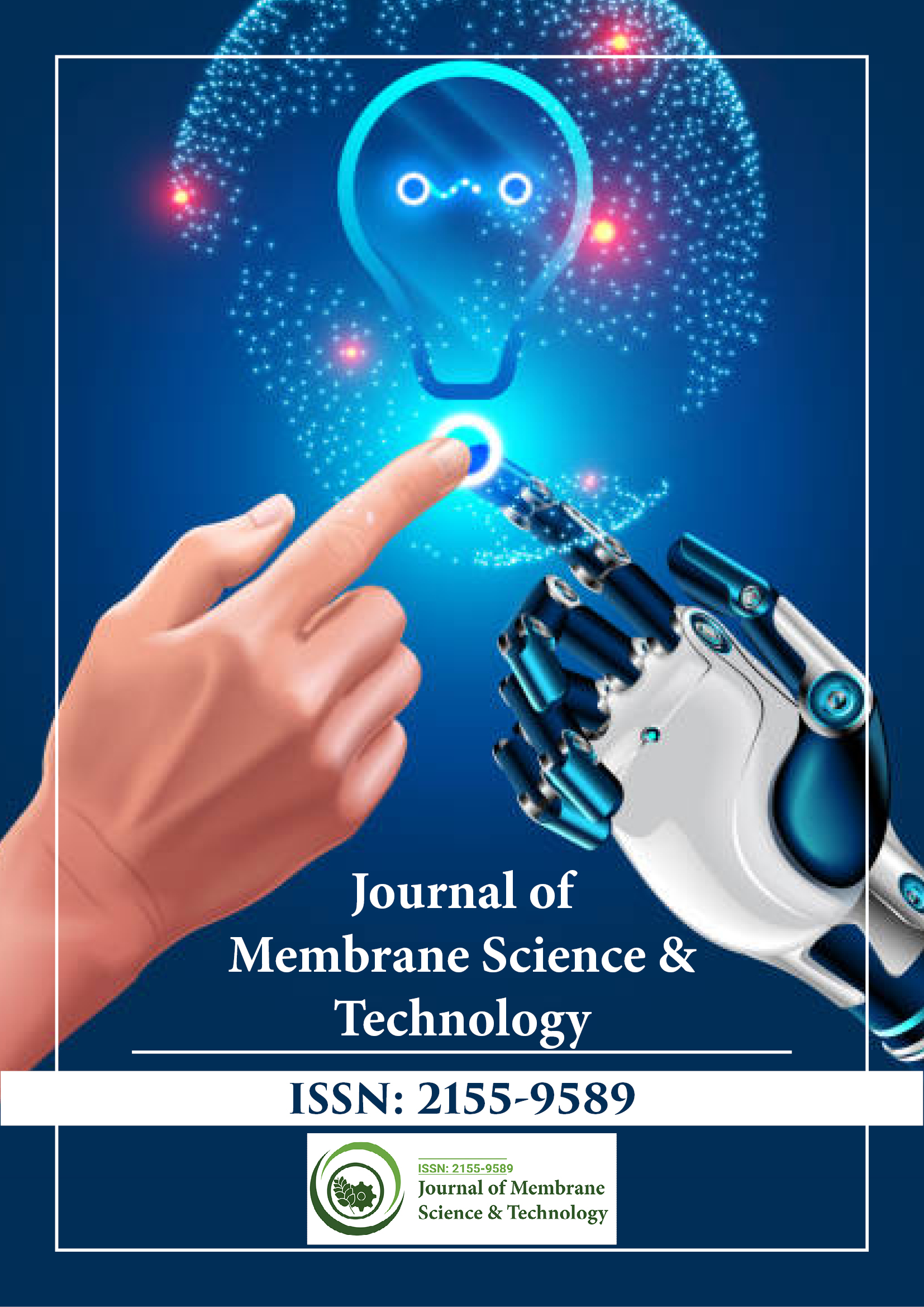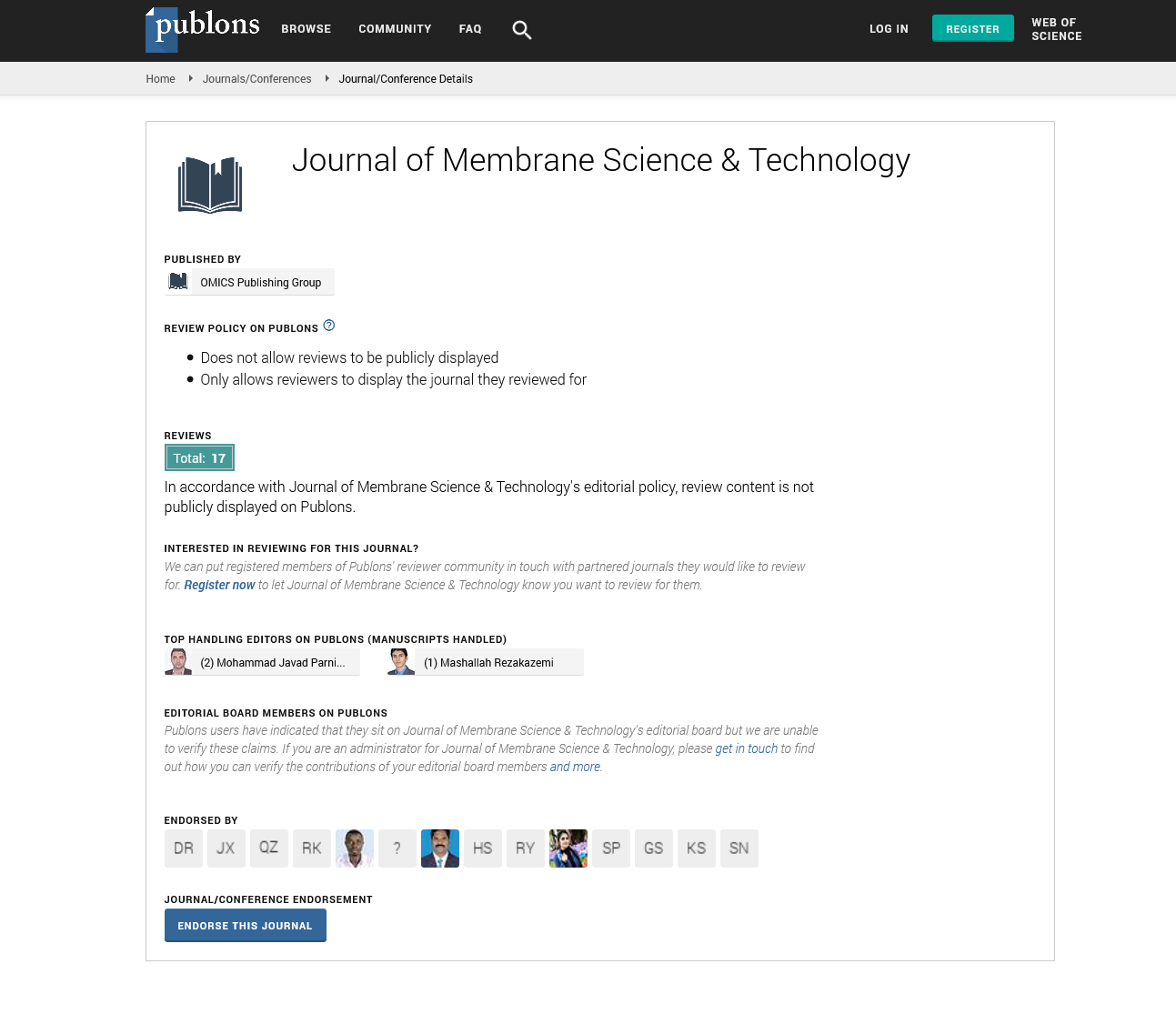Indexed In
- Open J Gate
- Genamics JournalSeek
- Ulrich's Periodicals Directory
- RefSeek
- Directory of Research Journal Indexing (DRJI)
- Hamdard University
- EBSCO A-Z
- OCLC- WorldCat
- Proquest Summons
- Scholarsteer
- Publons
- Geneva Foundation for Medical Education and Research
- Euro Pub
- Google Scholar
Useful Links
Share This Page
Journal Flyer

Open Access Journals
- Agri and Aquaculture
- Biochemistry
- Bioinformatics & Systems Biology
- Business & Management
- Chemistry
- Clinical Sciences
- Engineering
- Food & Nutrition
- General Science
- Genetics & Molecular Biology
- Immunology & Microbiology
- Medical Sciences
- Neuroscience & Psychology
- Nursing & Health Care
- Pharmaceutical Sciences
Perspective - (2025) Volume 15, Issue 1
Innovative Membrane Bioreactor Systems: Transforming Wastewater Treatment with Advanced Filtration and Biological Processes
Sonia Curcio*Received: 31-Jan-2025, Manuscript No. JMST-25-29281; Editor assigned: 03-Feb-2025, Pre QC No. JMST-25-29281 (PQ); Reviewed: 17-Feb-2025, QC No. JMST-25-29281; Revised: 24-Feb-2025, Manuscript No. JMST-25-29281 (R); Published: 03-Mar-2024, DOI: 10.35248/2155-9589.25.15.417
Description
Membrane bioreactor technology represents a transformative advancement in the field of wastewater treatment, combining biological degradation with advanced membrane filtration to produce high-quality effluent. As concerns over water scarcity, environmental impact and the need for efficient treatment solutions increase, Membrane Bioreactors (MBRs) are gaining traction globally. These systems offer a compact, efficient and versatile solution for both municipal and industrial wastewater treatment, enabling the production of clean water suitable for reuse or safe environmental discharge.
At the heart of MBR technology is the integration of two core components: a bioreactor and a membrane filtration unit. In the bioreactor, wastewater undergoes biological treatment, where microorganisms consume and break down organic pollutants, nutrients and suspended solids. This process mirrors the conventional activated sludge system, but with a critical difference in the separation stage. Instead of relying on gravity-based settling tanks, MBRs use membranes to physically filter out biomass and suspended solids. These membranes made from materials such as polymers or ceramics are available in various configurations including flat sheets, hollow fibers and tubular forms, each offering different advantages in terms of surface area, cleaning efficiency and operational resilience.
The operation of an MBR system begins when raw wastewater enters the bioreactor. Here, aerobic or anaerobic microorganisms metabolize the organic matter and nutrients. Following this, the mixed liquor, which contains treated water and biomass, is directed to the membrane unit. The membranes act as a barrier, allowing only clean water referred to as permeate to pass through while retaining bacteria, pathogens and suspended solids. The concentrated biomass is then recycled back into the bioreactor to maintain an active microbial population and any excess sludge is periodically removed for further processing. This configuration results in a highly effective and controlled treatment process capable of achieving stringent discharge or reuse standards.
One of the most notable advantages of MBR systems is the superior quality of the treated water. The membrane barrier ensures that the effluent is virtually free of pathogens and particulates, making it suitable for a wide range of non-potable reuse applications such as irrigation, industrial processes, or even indirect potable reuse in some cases. Additionally, the system’s compact design eliminates the need for large secondary clarifiers and other space-consuming components found in traditional treatment plants. This makes MBRs especially attractive for urban areas or locations where space is limited.
MBRs also offer improved sludge management, as they support higher biomass concentrations, resulting in more efficient pollutant degradation and reduced sludge production. Their ability to handle variable flow rates and changing wastewater compositions makes them ideal for both large-scale municipal treatment plants and smaller decentralized installations. Furthermore, the enclosed and automated nature of MBRs reduces odors and noise, contributing to better integration into residential or commercial environments.
Despite these strengths, membrane bioreactors are not without challenges. Membrane fouling is a common issue, where particles, biofilms, or other substances accumulate on the membrane surface, reducing permeability and increasing the need for cleaning and maintenance. This can lead to operational downtime and increased costs if not effectively managed. Energy consumption is another concern, as the aeration required to maintain microbial activity and to control membrane fouling can be higher than that in conventional systems. Additionally, the capital investment and operational expenses of MBR systems tend to be higher, especially when considering the costs associated with membrane replacement and system upkeep. The technology also demands a higher level of technical expertise for operation and monitoring, necessitating trained personnel and advanced control systems.
However, ongoing innovations are rapidly addressing these limitations. Researchers are developing more durable, fouling-resistant membranes with improved permeability and lifespan. Energy-efficient system designs are being explored, including optimized aeration strategies and smarter flow management, which aim to reduce power consumption without compromising treatment effectiveness. Advances in automation and digital monitoring, including the integration of sensors and artificial intelligence, are enabling real-time performance tracking, predictive maintenance and adaptive process control. Furthermore, hybrid systems that combine MBR technology with other treatment methods, such as advanced oxidation, reverse osmosis, or nutrient recovery processes, are showing promise in enhancing overall treatment capacity and achieving near-zero liquid discharge.
The flexibility and adaptability of membrane bioreactor systems make them suitable for a wide array of applications. They are increasingly used in municipal wastewater treatment to upgrade aging infrastructure or to meet stricter environmental regulations. In the industrial sector, MBRs are deployed to treat complex effluents from food processing, pharmaceuticals, textiles and chemicals. Their ability to produce high-quality reclaimed water is especially valuable in water reuse initiatives, where treated wastewater is repurposed for agricultural irrigation, industrial cooling, or groundwater replenishment.
Conclusion
In conclusion, membrane bioreactor systems are redefining the landscape of wastewater treatment by delivering a compact, efficient and high-performance solution to the growing challenges of water quality and sustainability. While the technology still faces obstacles related to cost and fouling, continuous advancements in membrane science, system integration and process automation are steadily improving its feasibility and affordability. As global demand for clean water intensifies, MBR technology is poised to play a critical role in ensuring safe, reliable and sustainable water management for both current and future generations.
Citation: Curcio S (2025). Innovative Membrane Bioreactor Systems: Transforming Wastewater Treatment with Advanced Filtration and Biological Processes. J Membr Sci Technol. 15:417.
Copyright: © 2025 Curcio S. This is an open-access article distributed under the terms of the Creative Commons Attribution License, which permits unrestricted use, distribution, and reproduction in any medium, provided the original author and source are credited.

